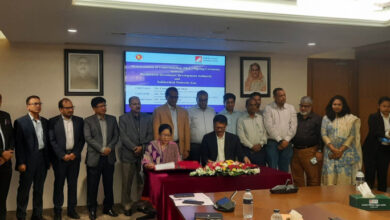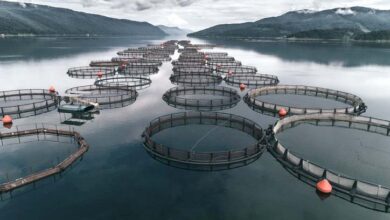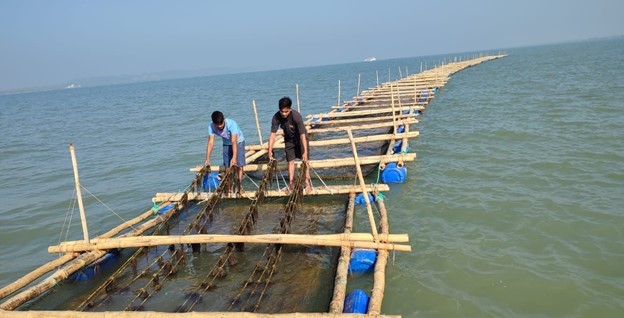
WORLDFISH has started a project called “Seaweed and Green Mussel production” for “Alternative income generating activities for poor coastal communities”. The Project implementing in collaboration with “Bangladesh department of fisheries”, “Chattogram Veterinary and Animal Sciences University (CVASU)” and Falcon International.
This project is funded by the United States Agency for International Development (USAID). It has started in 2019 and is set to end in 2024. The project site is located on the Southeast coast (Khuruskhul, Cox’s Bazaar; Amadoia khuta, Moheshkhali; Shadrang, Teknaf) of Bay of Bengal, Bangladesh.
It aimed to improve the livelihood of the locals through a potential seaweed species named Gracilaria tenuistipitata. Gracilaria is an important seaweed species which is tolerant to a wide range of environments and is an economically important raw material for agar production. Seaweeds of the family Gracilariaceae (Rhodophyceae) are well known for the production of agar-agar, protein, fiber, fatty acids, vitamins, macro and trace elements as well as important bio-active compounds.
Cultivation Period
Since the 1970s, this species has been cultivated in many countries using long-line ropes in a submerged free-floating system. Although Gracilaria is abundant year-round, it is less common during the warm months of March to May and most abundant after the monsoon season.
October to March is considered the ideal growing season for Gracilaria in Bangladesh. This year, however, cultivation was delayed as a result of cyclone Sitrang since the water became turbid. Consequently, the farmers lost four cycles or harvests from the season.
Methods of seaweed production vary widely depending on aspects such as cultivation facilities (in the open sea or on land), productivity and availability of species, dimensional properties, irradiance, temperature conditions, nutrient enrichment, water flow and wave action.
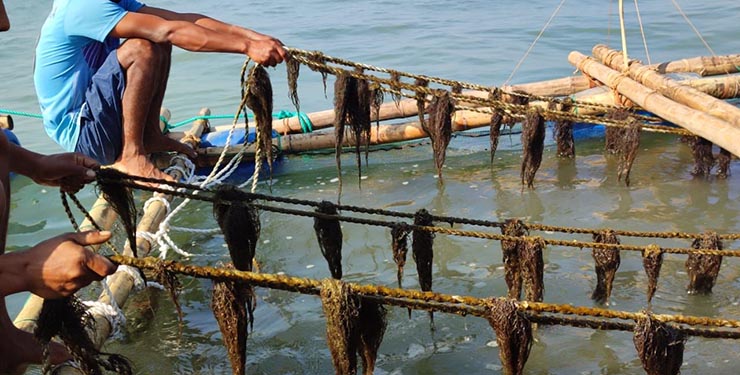
The success of seaweed farming is dependent not only on the environmental compatibility of the area but also to a significant degree on a variety of other factors that affect the production performance of seaweed. Gracilaria seaweed has a high environmental parameter tolerance. It can handle a broad range of salinity, from 10 to 40 ppt (parts per trillion), but grows best in the area of 25 to 33 ppt. Gracilaria may also tolerate temperature ranges between 10 and 35°C, however, its ideal range is between 24 and 30°C. Completely murky water is not suitable for its cultivation; instead, clearer water is necessary.
Culture Method
Seed collecting is a key phase in the Gracilaria cultivation process. Seed collection is dependent on the availability of natural sources during the season. Although setting up a nursery to lessen reliance on natural sources is suggested, seedstock is necessary for successful commercial agriculture. The seeding interval is a vital aspect of seaweed cultivation.
A traditional method for cultivating seaweed, known as seed-rope, involves growing macroalgae seedlings on the rope in regulated environmental conditions. This approach is highly efficient in seaweed farming because when it grows on ropes has lower production costs due to the shorter time required in the hatchery and because cultivation may be managed.
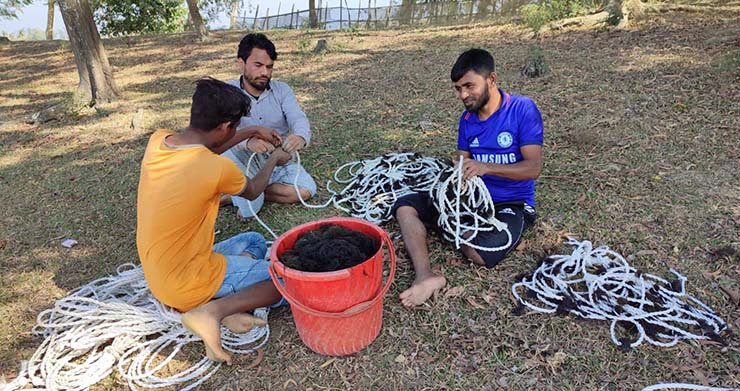
The rope-type cultivation method has a significant impact on the yield performance of Gracilaria seaweed. The seed of Gracilaria is stuck in the strands of the ropes which are attached in parallel position in the floating bamboo structure. A structure of 12ft x 30ft bed is made with Bamboo for the culture. Empty plastic drums are used as floats. This type of farming is also widely practiced in Indonesia, Brazil and many other seaweed growing nations.
The seaweed is attached to 1 m long, 6 mm in diameter nylon strands. The Gracilaria ropes are positioned between 0.2 and 0.3 meters below the water’s surface and each end is fastened to bamboo poles. Net bags are suspended in the water at a depth of 0.3 meters from the surface of the water to the bottom of the net bag and their corners are fastened to bamboo poles. The net bags are intended to prevent entering of herbivorous fish.
Gracilaria is harvested once it reaches 30 cm in length. Every month it is harvested 2 times which means every 15 days, the harvest takes place. Last year the production of this project was about 20 tons. This year the production can be calculated by the end of March.
Commercial Value
Raw Gracilaria seaweed price is sold at 40-60 Tk per kg depending on the season. However, the dried price is sold depending on the quality at 400-500 Tk. A total of 7 kilograms of raw seaweed can make 1KG dry. Gracilaria is farmed mainly for the Agar collection. The agar extraction ratio is a maximum of 25% from it. This means 4 KG of Gracilaria may provide 1 KG of Agar. However, Agar has high demand and the price is ranging 3000-8000 Tk depending on the quality. Agar is one of the most extensively used seaweed gums in the world. It is a polysaccharide produced from seaweed. Agar is widely employed in the manufacturing of jams and jellies, cosmetics, the pharmaceutical industry and microbiological research. Agar is utilized in the cosmetic sector as a stabilizer for emulsions and as a component of skin creams, ointments, lotions, etc.
Creating Entrepreneurs and Market
The project has created employment scope for the local community. Total 154 people were engaged in Gracilaria cultivation in 2019, the first year of the initiative. Then, in 2020, 2021, and 2022, 150, 200, and 100 individuals, respectively, joined. Under the guidance of project managers and scientists, they cultivate, harvest and market seaweeds.
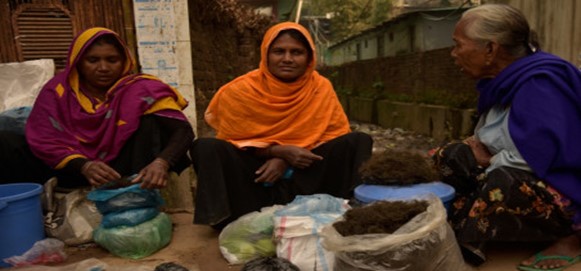
Now, a new strategy for the project has evolved. The strategy calls for the addition of 15 entrepreneurs, 5 farmers and 5 marketers who will focus on the creation, manufacture and distribution of seaweed-based products.
In addition, four persons work on this initiative as “points of contact,” i.e., when the farmers or no one else is around, they oversee the project. Essentially, these men are chosen from local farmers and compensated with 1,500 TK each month to oversee the project.
Prospects around the Globe
In 2015, the global output of farmed Gracilaria was 3.9 million tons, ranking third after Eucheuma and Japanese kelp. In 2015, China ranked first in Gracilaria production with a harvest of 2.7 million tons. There are 100 known species of Gracilaria in the world.
Chile, Japan, the Republic of Korea and the Taiwan Province of China are the primary regional producers and customers of food-grade agar at present. In Thailand and Vietnam, fresh G. tenuistipitata is usually used as a vegetable. In both fresh and dried forms, it is used in various delicious dishes. Besides, seaweed has good demand among locals in neighboring Myanmar as well.
Prospect in Bangladesh
About 32 species of seaweed are widespread along the coast of Bangladesh, of which 14 are commercially viable but only four are cultivated, albeit on a modest scale. It has been found that, among these seaweeds, the species Gracilaria (Rhodophyta) is the most preferable choice for intensive culture due to its potential to achieve high yields and generate economically valuable products.

Along its 710 km coastline facing the Bay of Bengal, Bangladesh is impacted by a rising population and periodic tidal bore. According to the Food and Agriculture Organization, Bangladesh has immense potential for Gracilaria production since its beaches, estuaries and mangroves make it a suitable habitat for the plant. The country has approximately 700 kilometers of coastline and 25,000 square kilometers of the coastal area.
Additionally, the coastal regions of Bangladesh are regularly inundated with saline water. Once crop fields are flooded with salt water, it takes around seven years to produce land crops. Therefore, Gracilaria might be a feasible choice for coastal people to cultivate on these inundated grounds. Gracilaria may also be utilized to produce a variety of delicious dishes.
In fact, Rakhaine and Chakma tribes consume the G. tenuistipitata that grows on the sand flat of Nuniachara adjacent to Moshekhali Channel in Cox’s Bazar. The nutritional assessment of this type of seaweed cultivated on a wide scale showed promising results.
It is also expected that boosting seaweed farming will aid in reducing pressure on marine fishing, as considerable manpower may be diverted from fishing to (seaweed) cultivation. It will help reducing use of fossil fuel and emission of carbon in atmosphere. Moreover, seaweed absorbs and stores significant amounts of carbon dioxide from the atmosphere, helping to mitigate the impacts of climate change.
Furthermore, Bangladesh imports the majority of its Agar powder from India, China, and Japan, making it the world’s top importer of Agar powder. Therefore, the cultivation of Gracilaria may assist Bangladesh in being self-sufficient in Agar production and save foreign currency.
Jaber Bin Abdul Bari
Department of Oceanography, NSTU


